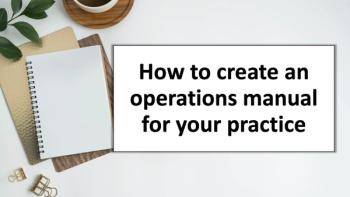
Cramped Office Space?
How to make the most of the office space you have -- and how much is enough
Patients are crowded into the waiting room, with more gathered around the front desk. All the exam rooms are filled, and office staff is tripping over each other as everyone tries to get through a full day's worth of appointments. We need more space, you think.
Another room ... or maybe three or four.
Before you give up and start looking for a new office, take a close look at your practice. "People can really adapt and work in almost anything," says Paul Yañez, principal designer and president of Medical Space Planners in Morro Bay, Calif. The key is to understand how your space is really being used.
Is it a money-maker?
The first step is to take a look at areas that don't directly generate income and see how they can be better organized -- or perhaps eliminated altogether. Billing and collections, coding, and record-keeping are all crucial, but they also monopolize a lot of square footage.
According to Richard Haines, president of Medical Design International in Tucker, Ga., space should be viewed as either revenue-generating or nonrevenue-generating. "Exam rooms generate revenue, labs generate revenue, X-ray generates revenue," says Haines. "You want to make sure you have enough of those spaces that you optimize your income stream."
"We do a lot of remodeling with people who have outgrown their space," says Yañez. "Normally, when they really outgrow their space it's not because of exam rooms, it's usually the business function. The business function grows because the practice grows, and billing becomes a larger item."
So consider: Could you outsource billing and collections? How about transcription? You might pay a little more for these outside services, but the space you recover could be worth the expense.
If that idea is too drastic, then consider what Yañez did for a client who needed more space. Instead of eliminating the billing office entirely, they simply moved the department to another rented space on a different floor of the same building. "We took 1,200 square feet and moved those five people," says Yañez. "By doing that, we brought another doctor into the group and added another two exam rooms." The addition of a doctor more than offset the added cost of the new rental space.
Find another way to file
If you're like most practices, one long wall or one room in your practice is devoted to patient charts. Consider installing a new filing system such as rotating cabinets that can halve the amount of space files occupy. You may incur some expense for the new system -- rotary cabinets can cost between $1,200 and $1,800 per unit -- but it beats the 30 percent or 40 percent monthly increase of a new lease. And you can use the newfound space to generate revenue with an extra exam room or added diagnostic equipment.
Then again, maybe you have more files than you need. "I have [clients] who want to hold files forever," says Yañez. "If you have 5,000 charts, that's ridiculous. If you get to that point, you're paying $3 per square foot for rent. You ought to purge those and put them in a storage bin, where you're paying 55 cents per square foot."
Another possibility is to switch to an electronic medical record (EMR). "It depends on the size of the practice, but EMR does have the potential to eliminate your file room," says Haines. Implementing an EMR carries its own set of challenges, including integrating past records into the new system; but then again, a paperless office doesn't need file space.
One more option to consider is having older patient records scanned to disk. There are a number of document scanning companies that can do this relatively inexpensively -- and you'll be exchanging a giant six-foot metal cabinet for a shoebox full of CD-ROMs.
Revisit social spaces
Do you have a break room or conference area? Not only could that space be better used, it might be interrupting the workflow of your practice.
"We had this central conference room that was dysfunctional," says Jane Grant-Kels, MD, professor and chairperson of the dermatology department at the University of Connecticut Health Center in Farmington. "It was nice because it enhanced collegiality, but it was dysfunctional for efficiency."
Grant-Kels hired Haines as a consultant, and he discovered that the five doctors and four other medical staff members were using the conference room as a central meeting point between exam room appointments to consult patient records, to finish paperwork, and to gab with colleagues.
"[Haines] actually sat with a timer and watched us," says Grant-Kels. "He said we could see at least one more patient an hour in the time we were just walking back and forth to the conference room."
His solution was to eliminate the conference room altogether and establish "pods" -- three rooms with a workstation to every physician. The result? The overall efficiency for the department improved by over 40 percent. And despite having lost a physician in the interim, the department now sees 20 percent more patients than they did when they were at full staff.
"Our productivity and the money we've brought in for the health center has gone way up, and I think that job satisfaction has also gone up," says Grant-Kels. "People feel like they're functioning more like physicians."
No more desk duty
How often do you use your office? That's a question many space-conscious physicians should be asking themselves.
"Fifteen years ago, when a doctor made his own money, he'd get a 12-by-14 consult and have a couch in there and a full, private bathroom," says Yañez. "A lot of doctors are actually sharing a consult now. Or they don't consult in the room."
With the vast majority of patient interaction occurring in exam rooms, the traditional doctor's office is sometimes no more than a space to finish charts, do paperwork, and make phone calls. If space is at a premium, it might be time to think about downsizing these personal rooms. Larger practices might consider a communal office shared by several physicians or small, cubicle-like workstations for filling out paperwork.
On the other hand, warns Haines, be prepared for some resistance. "[Offices] are a hard thing for the group to give up if they've got them." But that's not to say it can't be done. Haines cites the example of a recent client: "We did have a [single-physician] practice on Long Island, where rent is extremely expensive. The doctor put a desk in each of the exam rooms and didn't have a private office." The physician effectively turned every room into usable office space with this simple strategy -- and turned his former office into a revenue-generating exam room.
The front of the house
Once you've looked hard at the business side of your practice, it's time to pay some attention to patient space. The waiting room can be the most poorly planned area in a medical practice. After all, it's just a room with some couches and chairs, right?
A seat isn't always just a seat, as Haines explains. "[Patients] don't like to sit on couches or loveseats," he says. And that is actually a good thing. "Typically you're better served by having individual chairs, which oftentimes you can pack a little tighter than you can with having couches. Also, if you go to a more modern chair, the area they take up is less than an early American chair."
You should also consider how many waiting room seats are taken by people who are not really patients. If patients bring friends or family members to a visit, the extra bodies can quickly turn your waiting room into a mob scene. Let your patients know when they make their appointments that space is limited, and request that if they are bringing someone with them that they bring only one person.
By far the least efficient consumer of space is the front desk. Especially in small practices, the front desk often serves double duty as the check-in and check-out areas. If patients are standing on one side of the waiting room door to get in, while others are waiting on the other side to make payments and leave, you can bet there will be a traffic jam. There might be only a minute or two delay per patient, but those minutes can add up to an hour or more by the end of the day -- an hour you could have used to see more patients.
There's no easy solution to front-desk congestion, but try dividing the check-in and check-out areas as much as possible. Even a small desk for signing forms and completing copays, placed a few feet from the waiting room door, can help thin traffic. Or consider installing a separate exit door; be sure to mark both doors clearly to help keep the flow of patients moving.
Is it really a space issue?
Sometimes it's not a matter of too little space but too many people, in which case it might be time to rethink working arrangements. "In multiple-doctor groups, take a look at the physician schedule," says Haines. "In a lot of practices that are not very disciplined, you can have five doctors in on Monday and one in on Tuesday. You really get these peaks and valleys in terms of physician access to the office, which means that you then are consuming more space."
Plan schedules so that there's a consistent flow of physicians throughout the week. Not only will that balance the number of staff, it will help alleviate patient congestion on those days.
On the other hand, you may simply have too few staff members. What seems like a large influx of patients and a scarcity of space may actually be a slow turnover of exam rooms. In that case, you might think about adding another medical assistant.
"The key for the doctor is that he should never wait -- an exam room should be ready every time he comes out of one," says Haines. "Once in an exam room, a patient should be ready to be seen, but the logistics of that get bogged down because the medical assistant is tied up doing something else." Extra staff can keep patients in steady rotation.
There's no doubt that making changes in the way you use available space can make a big difference in the success of your practice. After adapting to their space, Grant-Kels can see the difference in her own performance. "I have 24 patients booked tomorrow morning," she says. "Normally I would have had 15, so it's a big jump."
Robert Anthony is managing editor, special projects for Physicians Practice. He can be reached at
Newsletter
Optimize your practice with the Physicians Practice newsletter, offering management pearls, leadership tips, and business strategies tailored for practice administrators and physicians of any specialty.














